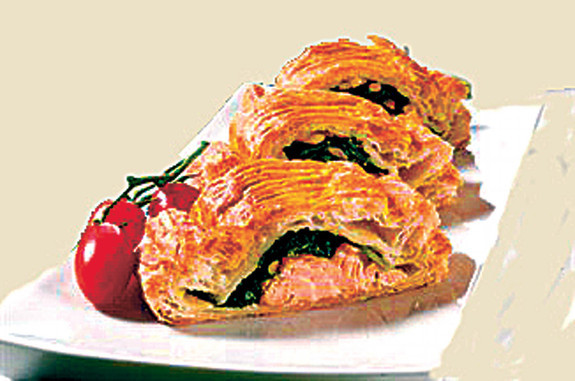In the final days before Shavuot … it’s a wrap!
Judy’s off one more week (mazel tov on her son’s wedding!), so we’re running a version of a favorite pre-Shavuot column.
Seems like yesterday that I wrote about the chocolate cheesecake truffles recipe for Shavuot … oh, wait a minute it was yesterday that I wrote about it. I’m kind of a last minute, “Judy we need the column, we’re about to go to press,” kind of person.
I really do have the best intentions of getting in my column by deadline each week, but I fail miserably and thankfully I have a very kind editor who puts up with me. Next week’s recipe? You guessed it, spare ribs or rib steak…
I actually had a recipe in mind for this week, having gotten it from my good friend Ellen Finkelstein while we were cruising. The rare time spent on the ship not eating, we were discussing food. She’s an amazing cook and baker so I decided to pick her brain. It’s a great dairy main course or appetizer that you can try out for Shavuot. It’s a great way to prepare salmon for those bored of the usual baked, poached or grilled versions. It’s salmon, Alouette garlic and herb cheese and spinach wrapped in pastry.
How did the custom of wrapping fish or meat in pastry come about you ask?
Having embarked on my cruise from England, let’s talk about the different types of pastry that are made in Britain that evolved over the last few centuries. They all evolved from a crude flour and water dough mixture invented by the Romans. It was sort of a paste that was wrapped around the main meal before roasting. It wasn’t meant to be eaten, it was just used so that the meat or fish would retain its juices and aromas. It was a tough piece of dough without flavor and was very chewy and hard to eat.
As time passed, changes were made to the dough by adding types of fat and milk. By medieval times, dough (crust) known as coffers started to be as important as the fruit, meat or fish it was protecting.
Romans used a variety of meats and fish as filling and a mixture of flour, oil, and water to keep it in. This ‘pastry’ cover was not meant to be eaten and was thrown away.

 60.0°,
Mostly Cloudy
60.0°,
Mostly Cloudy 




